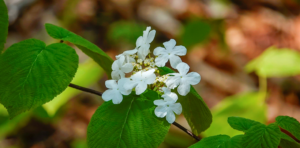– by Dave Schroeder
Hobblebush (Viburnum lantanoides) (V. Alnifolium) , also known as the witch hobble and triptoe, is one of our more showy native shrubs. It is most often found growing in the cool, moist environment of a ravine community. The common name, hobblebush, comes from the fact that the reclining branches often root at the tips, which provides a snare to trip the unaware woods traveler.

Image from Adirondack Nature
This shrub is 6 to 10 feet tall at maturity and easily recognized by its large leaves, which are 4 to 8 inches across and broadly ovoid. Leaves are borne opposite each other on the stem and the base of the leaf is heart shaped. Flat clusters of flowers usually appear in June. A rather unusual feature is that the cluster consists of two types of flowers, an inner group that are rather nondescript and an outer, showy, white group, each with 5 petals. The fruit is a red drupe, ripening to purple, borne in clusters. Twigs are covered with a scruffy, rusty pubescence and the buds are naked (without scales).
There has been an increased use of native plants in the landscaping efforts of many Connecticut homeowners. Hobblebush is attractive all year long and can be quite spectacular when in full flower. It is one of the first plants to leaf out in the early spring and will grow well in the shade. It also is a shrub that is attractive to wildlife. Unfortunately, this includes deer and you may have to use repellents or mechanical protection (tree tubes) to get the plant established. Small mammals and many birds, such as ruffed grouse, cedar waxwings, pileated woodpeckers, and turkey eat the fruit. The fruit is said to be quite tasty, however, you have to get them before the birds!
Originally published in the ECFLA/WDLT newsletter, Volume XXXIV, No.1, Spring 2011

